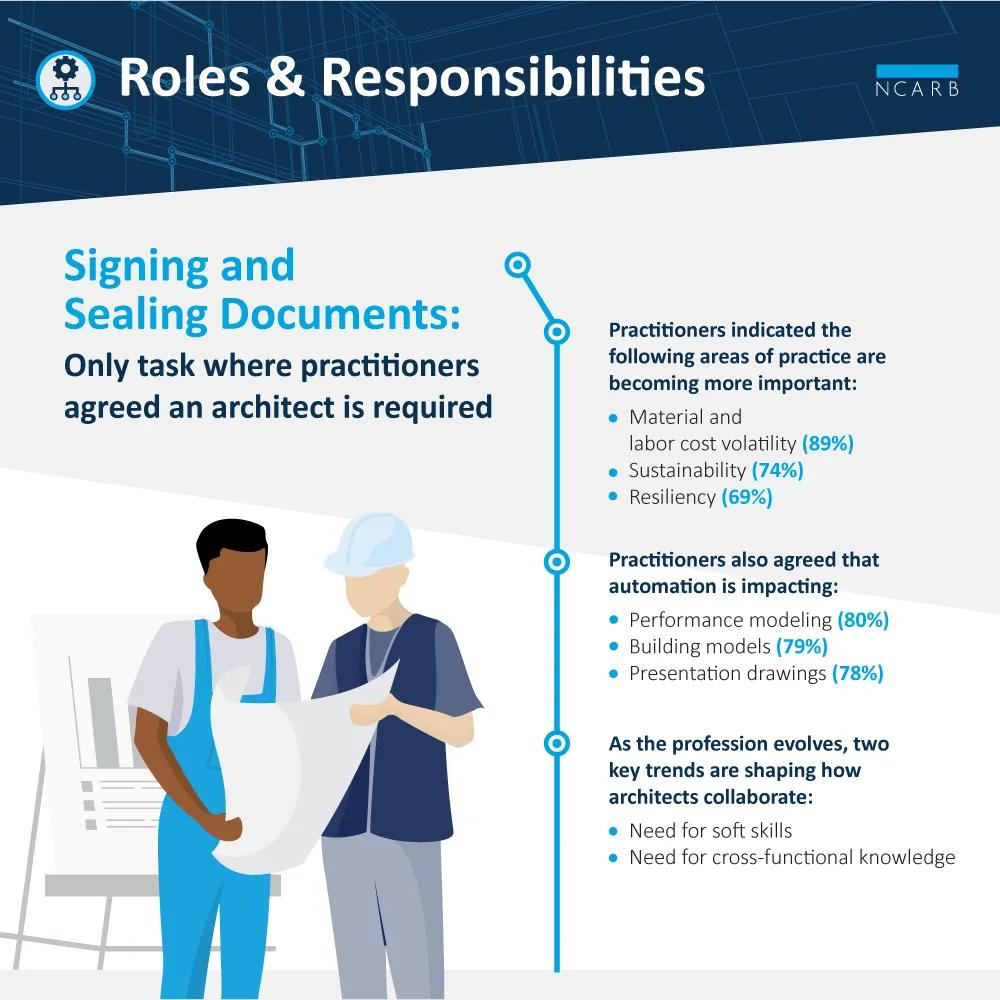Understanding the work that architects carry out at various career stages is one of the core purposes of the Analysis of Practice—including identifying tasks that vary across firm sizes, practice locations, and more. We surveyed thousands of practitioners about the roles they take on, how they collaborate, and how technology is impacting their responsibilities.

Role of the Architect
One of the key areas of focus for this section of the Analysis of Practice was identifying which roles could only be taken on by an architect, and which could be taken on by other contributors. Most respondents (83%) agreed or strongly agreed that there are essential components of a project that require an architect’s approval, even if they are not overseeing a project.
The only task a majority of respondents agreed could only be done by an architect was signing and sealing documents. Other tasks frequently identified were health, safety, and welfare considerations; regulatory responsibilities; and code compliance.

Explore the Full Analysis of Practice Report
Read through all the results from NCARB's 2020 Analysis of Practice report to understand the current state of the profession.
Top Trends
When asked about the trends that shape architects’ roles and responsibilities, the top two responses related to architects’ collaboration with other professionals: a greater need for soft skills (92%) and a need for cross-functional knowledge (90%).
Other trends related to the increasing need for sustainability and adaptive reuse of buildings, as well as an increase in gender diversity.
Respondents were also asked to identify areas of practice that had become more important in the past 10 years. The top five areas were:
- Material and labor cost volatility (89%)
- Sustainability (74%)
- Resiliency/building performance (69%)
- Accessibility (61%)
- Material understanding (59%)
Impact of Technology and Automation
With the use of technology increasing—especially in areas such as 3D modeling and rendering; virtual reality; parametric software; and performance modeling—the role of the architect has shifted. Respondents indicated that automation significantly changed architects’ responsibilities in the following areas:
- Performance modeling (80%)
- Building models (physical and virtual) (79%)
- Presentation drawings (78%)
- Perspective drawings (77%)
- Clash detection/conflict resolution (76%)
Project Team Makeup
Respondents agreed that project teams are put together fairly and based on team member experience and expertise—with very little variation across demographic groups and experience levels.
Other important factors at play when assembling project teams were complexity, the client’s needs, and the overall communication plan.
Top Roles
Respondents were asked to identify the various roles that architects would take on at each career stage. The top five most commonly selected roles for each career stage are below:
| Junior Architect | Intermediate Architect | Senior Architect | Other Contributor |
| Being mentored | Developing construction documents | Interacting with clients | Marketing/business development |
| Drafting | Participating in large projects | Participating in large projects | Participating in large projects |
| Physical modeling | Sketching | Leading projects | Performance modeling |
| Participating in large projects | Working independently | Mentoring | Completing project financials |
| Sketching | Developing production drawings | Client presentations | Business management |
Demographic Differences
Throughout the roles and responsibilities section of the study, there was widespread agreement regarding the various tasks that architects are responsible for at each career level, as well as the impact of technology and trends. Slight demographic differences included:
- People of color were more likely than their white peers to see team size and team diversity as highly important when setting up a project team
- While white respondents were most likely to select “being mentored” as the top role a junior architect would take on, people of color were most likely to select “CAD/BIM modeling”
- While respondents largely agreed on the primary role of an architect at each career stage, individuals who had been licensed for 20+ years were typically out of step with those licensed more recently. For example: While respondents who had been licensed for 20+ years selected “sketching” as the top role of an intermediate architect, respondents licensed in the last 10 years selected “developing construction documents”
- Men were more likely than women to agree that more women were entering the profession, and white respondents were more likely than people of color to agree that the profession is increasingly diverse
What’s Next?
Over the coming years, NCARB will continue exploring the key roles and responsibilities of architects and how they shape the competencies required for licensure. Findings from the Analysis of Practice will inform what the licensure process will look like in the future.
About the Analysis of Practice
In 2022, over 19,000 individuals across the architecture, engineering, and construction (AEC) industry participated in NCARB’s once-in-a-decade Analysis of Practice study. Through a series of short questionnaires, focus groups, a final extensive survey, and more, NCARB gathered key insights about the field of architecture that will help shape the licensing model of the future. Results from the study will help us better understand the ecosystem of architectural practice and may lead to changes to NCARB’s national licensing programs and standards of the future.